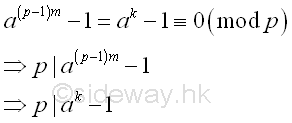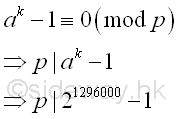Content
Pollard's p-1 Method
Pollard's p-1 Algorithm
Pollard's p-1 Method
Smooth Number Method
Smooth Number
Example of
Smooth Number
Pollard's P-1 Methed by
Smooth Number
Pollard's P-1 Methed by
Smooth Number Example 1
Pollard's p-1 Method
Pollard's p-1 method is a prime factorization algorithm discovered by John Pollard in 1974. Limited by the algorithm, the Pollard's p-1 method is only work for integers with specific factors.
Pollard's p-1 Algorithm
For a composite integer, n, with a prime factor p, if p-1 can be expressed in terms of a product of primes and k is a multiple of p-1. By selecting an integer, a, which is greater than 1 and is coprime to n, then

Imply

Since a is coprime to n, a is coprime to p also. Imply

From Fermat's little theorem, if p does not divide a, then

Similarly, If k is a multiple of p-1, then

Imply p is a non-trivial divisor of ap-1-1 or ak-1 .
 or
or 
Since p is also a prime factor of n, p divides the greatest common divisor of ap-1-1 or ak-1, and n.
 or
or 
Therefore, if the greatest common divisor of ak-1, and n is greater than 1, the greatest common divisor is a factor of n also.
Pollard's p-1 Method
Although the Pollard's p-1 algorithm cannot be used to determine the prime factor p directly, the Pollard's p-1 method is an efficient prime factor finding method for composite integers with specific types of prime factors by choosing and testing some integers systematically.
Smooth Number Method
Smooth Number
One of the number choosing method for integer k is the making use of the concept of smooth number and the specific type of prime factor, i.e. p-1 is the product of primes.
Let x and B be integers. x is said to be B-smooth if all the prime divisors of n are less than or equal to B.

Example of Smooth Number
| B | B-smooth numbers | Prime Factors |
|---|---|---|
| 2,3,5,7,11,... | 1 | 20,30,50,70,110,... |
| 2,3,5,7,11,... | 2 | 21, |
| 3,5,7,11,... | 3 | 31, |
| 2,3,5,7,11,... | 4 | 22, |
| 5,7,11,... | 5 | 51, |
| 3,5,7,11,... | 6 | 21,31, |
| 7,11,... | 7 | 71, |
| 2,3,5,7,11,... | 8 | 23, |
| 3,5,7,11,... | 9 | 32, |
| 5,7,11,... | 10 | 21,51, |
| 11,... | 11 | 111, |
| 3,5,7,11,... | 12 | 22,31, |
| 7,11,... | 14 | 21,71, |
| 5,7,11,... | 15 | 31,51, |
| 2,3,5,7,11,... | 16 | 24, |
| 3,5,7,11,... | 18 | 21,32, |
| 3,5,7,11,... | 24 | 23,31, |
| 2,3,5,7,11,... | 32 | 25, |
| 2,3,5,7,11,... | 64 | 26, |
| 11,... | 77 | 71,111, |
| 5,7,11,... | 120 | 23,31,51, |
| 5,7,11,... | 360 | 23,32,51, |
| 5,7,11,... | 1800 | 23,32,52, |
Although B is usually a prime number, B can be a composite number providing that B is greater than or equal to the largest prime factor of x. The key information from a B-smooth number is the prime factor of a number. However, there is no information on the power or index of the prime factor. The lowest B-smooth of a number is the greatest prime factor of the number.
Pollard's P-1 Methed by Smooth Number
Since p-1 divides k, by assuming p-1 is B-smooth, if k is also B-smooth then the choosen integer k should be sufficienly large to ensure p-1 divides k. Therefore k is the product of all prime factors with powers less than and equal to B and the index or power ei for each prime factor pi less than and equal to B of k should be just less than and equal to n. Imply

Pollard's P-1 Methed by Smooth Number Example 1
For example: n=203=p*q=7*29; let B=5 imply
| Integer | B-smooth number | Prime Factors | number |
|---|---|---|---|
| k | 5 | 27*34*53 = 128*81*125 | 1296000 |
Therefore for B=5, k5 or (p5-1)m5 is equal to 1296000.
Fermat's Little Theorem
let a=2, by Fermat's little theorem, let p be one of the prime factors of n, imply

Greatest Common Divisor
Since ak-1 is a very large number, before finding the greatest common divisor of n and ak-1, ak-1 can be raised to the high power modulo n. Imply
Using squarings modulo
| base | number; a=2; k=1296000; n=203 |
|---|---|
| ak base 10 | 21296000 |
| ai base 10 | 21 = 21 ≡ 2 (mod 203) |
| 22 = 22 ≡ 4 (mod 203) | |
| 24 = 42 ≡ 16 (mod 203) | |
| 28 = 162 ≡ 53 (mod 203) | |
| 216 = 532 ≡ 170 (mod 203) | |
| 232 = 1702 ≡ 74 (mod 203) | |
| 264 = 742 ≡ 198 (mod 203) | |
| 2128 = 1982 ≡ 25 (mod 203) | |
| 2256 = 252 ≡ 16 (mod 203) | |
| 2512 = 162 ≡ 53 (mod 203) | |
| 21024 = 532 ≡ 170 (mod 203) | |
| 22048 = 1702 ≡ 74 (mod 203) | |
| 24096 = 742 ≡ 198 (mod 203) | |
| 28192 = 1982 ≡ 25 (mod 203) | |
| 216384 = 252 ≡ 16 (mod 203) | |
| 232768 = 162 ≡ 53 (mod 203) | |
| 265536 = 532 ≡ 170 (mod 203) | |
| 2131072 = 1702 ≡ 74 (mod 203) | |
| 2262144 = 742 ≡ 198 (mod 203) | |
| 2524288 = 1982 ≡ 25 (mod 203) | |
| 21048576 = 252 ≡ 16 (mod 203) | |
| ak base 10 | 21048576+131072+65536+32768+16384+1024+512+128 |
| ak base 10 | 21048576*2131072*265536*232768*216384*21024*2512*2128 |
| ak base 10 | 16*74*170*53*16*170*53*25 ≡ 197 (mod 203) |
Using binary squarings modulo
| base | number; a=2; k=1296000; n=203 |
|---|---|
| k base 10 | 1296000 |
| k base 2 | (100111100011010000000)2 |
| k base 10 | 220+217+216+215+214+210+29+27 |
| ak base 10 | 21296000 |
| ak base 10 | 2^220+2^217+2^216+2^215+2^214+2^210+2^29+2^27 |
| ak base 2 | 10100111100011010000000 |
| ai base 10; a=2 | 0:(1*(a^0))2 = a0 ≡ 1 (mod 203) |
| 1:(1*(a^1))2 = a2 ≡ 4 (mod 203) | |
| 0:(a2*(a^0))2 = a4 ≡ 16 (mod 203) | |
| 0:(a4*(a^0))2 = a8 ≡ 53 (mod 203) | |
| 1:(a8*(a^1))2 = a18 ≡ 71 (mod 203) | |
| 1:(a18*(a^1))2 = a38 ≡ 67 (mod 203) | |
| 1:(a38*(a^1))2 = a78 ≡ 92 (mod 203) | |
| 1:(a78*(a^1))2 = a158 ≡ 158 (mod 203) | |
| 0:(a158*(a^0))2 = a316 ≡ 198 (mod 203) | |
| 0:(a316*(a^0))2 = a632 ≡ 25 (mod 203) | |
| 0:(a632*(a^0))2 = a1264 ≡ 16 (mod 203) | |
| 1:(a1264*(a^1))2 = a2530 ≡ 9 (mod 203) | |
| 1:(a2530*(a^1))2 = a5062 ≡ 121 (mod 203) | |
| 0:(a5062*(a^0))2 = a10124 ≡ 25 (mod 203) | |
| 1:(a10124*(a^1))2 = a20250 ≡ 64 (mod 203) | |
| 0:(a20250*(a^0))2 = a40500 ≡ 36 (mod 203) | |
| 0:(a40500*(a^0))2 = a81000 ≡ 78 (mod 203) | |
| 0:(a81000*(a^0))2 = a162000 ≡ 197 (mod 203) | |
| 0:(a162000*(a^0))2 = a324000 ≡ 36 (mod 203) | |
| 0:(a324000*(a^0))2 = a648000 ≡ 78 (mod 203) | |
| 0:(a648000*(a^0))2 = a1296000 ≡ 197 (mod 203) | |
| ak base 10 | 21296000 ≡ 197 (mod 203) |
and using the residue to calculate the greatest common divisor. Imply

The greatest common divisor of n and ak-1 is
Using Euclid's algorithm
| ak-1 | n |
|---|---|
| 21296000-1 | 203 |
| 197-1 | 203 |
| 196 | 203 |
| 196 | 203-196 |
| 196 | 7 |
| 196-7*28 | 7 |
| 0 | 7 |
Imply

Integer 7, the greatest common divisor of n and ak-1 is also the prime divisor of n. And p-1 is 5-smooth.
| Integer | B-smooth number | Prime Factors | number |
|---|---|---|---|
| p-1 | 3, 5 | 21*31 | 6 |
| k | 5 | 27*34*53 = 128*81*125 | 1296000 |
| k/(p-1) | 26*33*53 | 216000 |
Since the greatest prime factor of p-1 is 3-smooth also. And therefore the prime factor 7 can also be found by using B=3
| Integer | B-smooth number | Prime Factors | number |
|---|---|---|---|
| p-1 | 3 | 21*31 | 6 |
| k | 3 | 27*34 = 128*81 | 10368 |
| k/(p-1) | 26*33 | 1728 |
let a=2, by Fermat's little theorem, imply p divides 210368-1 ≡ 168 (mod 203)
The greatest common divisor of n and ak-1 is gcd(168,203)= 7
And 7 is the prime divisor of n as before.
©sideway
ID: 120500004 Last Updated: 5/15/2012 Revision: 1
Latest Updated Links
- Travel Singapore Sight Mandai(last updated On 12/8/2025)
- Travel Singapore Sight Bird Paradise(last updated On 12/7/2025)
- Travel Singapore Sight(last updated On 12/6/2025)
- Travel Singapore Rail Network(last updated On 12/5/2025)
- Travel Singapore Things to Know(last updated On 12/4/2025)
- Travel Singapore(last updated On 12/3/2025)
- Legrand Galion(last updated On 12/2/2025)
- Schneider Electric AvatarOn(last updated On 12/1/2025)
- Alfalux(last updated On 11/30/2025)
- Novabell(last updated On 11/29/2025)
- TownGas NJW12RM1(last updated On 11/28/2025)

 Nu Html Checker
Nu Html Checker  53
53  na
na  na
na
Home 5
Business
Management
HBR 3
Information
Recreation
Hobbies 9
Culture
Chinese 1097
English 339
Travel 24
Reference 79
Hardware 54
Computer
Hardware 259
Software
Application 213
Digitization 37
Latex 52
Manim 205
KB 1
Numeric 19
Programming
Web 289
Unicode 504
HTML 66
CSS 65
SVG 46
ASP.NET 270
OS 431
DeskTop 7
Python 72
Knowledge
Mathematics
Formulas 8
Set 1
Logic 1
Algebra 84
Number Theory 206
Trigonometry 31
Geometry 34
Calculus 67
Engineering
Tables 8
Mechanical
Rigid Bodies
Statics 92
Dynamics 37
Fluid 5
Control
Acoustics 19
Natural Sciences
Matter 1
Electric 27
Biology 1
